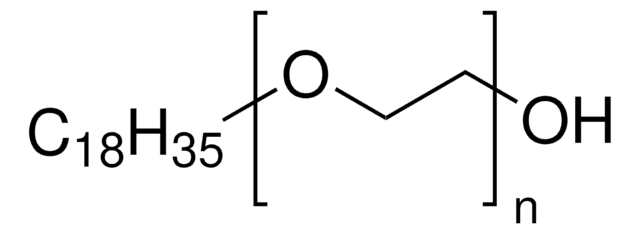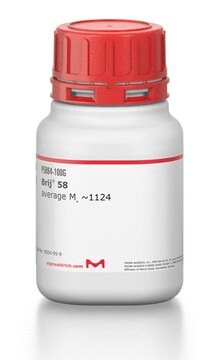STS0214
ECO BRIJ® O20
average Mn ~1,150
Sinónimos:
BRIJ® O20, Polyoxyethylene (20) oleyl ether
About This Item
Productos recomendados
descripción
non-ionic
Nivel de calidad
Formulario
solid
mol peso
average Mn ~1,150
características de los productos alternativos más sostenibles
Use of Renewable Feedstocks
Design for Degradation
Learn more about the Principles of Green Chemistry.
sustainability
Greener Alternative Product
mp
25-30 °C (lit.)
valor hidroxilo
50‑65 mg KOH/g
solubilidad
water: soluble 1 g/L at 20 °C
densidad
0.901 g/cm3 at 20 °C
HLB
15.5
categoría alternativa más sostenible
InChI
1S/C20H40O2/c1-2-3-4-5-6-7-8-9-10-11-12-13-14-15-16-17-19-22-20-18-21/h9-10,21H,2-8,11-20H2,1H3/b10-9-
Clave InChI
KWVPFECTOKLOBL-KTKRTIGZSA-N
¿Está buscando productos similares? Visita Guía de comparación de productos
Descripción general
Características y beneficios
- 100 % Renewable
- 100 % Bio-based
- Certified to the USDA BioPreferred Program
- Lower carbon footprint than petrochemical-based versions
- High-purity chemical suitable for a wide variety of research applications
Otras notas
Información legal
Palabra de señalización
Warning
Frases de peligro
Consejos de prudencia
Clasificaciones de peligro
Aquatic Chronic 2 - Skin Irrit. 2
Código de clase de almacenamiento
11 - Combustible Solids
Clase de riesgo para el agua (WGK)
WGK 1
Punto de inflamabilidad (°F)
>464.0 °F - Equilibrium method
Punto de inflamabilidad (°C)
> 240 °C - Equilibrium method
Elija entre una de las versiones más recientes:
Certificados de análisis (COA)
Lo sentimos, en este momento no disponemos de COAs para este producto en línea.
Si necesita más asistencia, póngase en contacto con Atención al cliente
¿Ya tiene este producto?
Encuentre la documentación para los productos que ha comprado recientemente en la Biblioteca de documentos.
Nuestro equipo de científicos tiene experiencia en todas las áreas de investigación: Ciencias de la vida, Ciencia de los materiales, Síntesis química, Cromatografía, Analítica y muchas otras.
Póngase en contacto con el Servicio técnico




